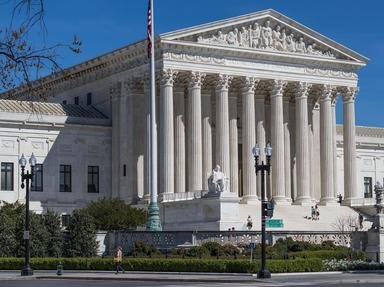Quiz Answer Key and Fun Facts
1. All aboard! We begin our tour at the Lincoln Memorial, on the shore of the Potomac. What architect designed this memorial?
2. Going east on Independence Avenue and looking across the Tidal Basin you see the white dome of the Jefferson Memorial. Inside the memorial you will find excerpts from the two documents for which Jefferson most wanted to be remembered: the Declaration of Independence and _________.
3. Not far from the Jefferson Memorial, on 14th Street, is the US Bureau of Engraving and Printing, established in 1862. You can take a tour of this building and actually see money being made. You learn that all US currency is produced using the intaglio method. What does this mean?
4. Coming up Jefferson Street, we come to two art museums of the Smithsonian, the Freer and Sackler Galleries. In the Freer Gallery, you can see the beautiful Peacock Room, which is dedicated to the works of this famous American artist.
5. A few doors down is the National Museum of African Art, which is dedicated to the works of traditional African artists. One of the exhibits, "The Ancient Nubian City of Kerma", features 40 art objects of Kerma, which was known to the ancient Egyptians as Kush. In what modern-day African nation is this city located?
6. On the right side of the mall facing the Capitol is the National Air and Space Museum, the most visited museum in town. One of the many things you can see is the command module that brought the astronauts back to Earth after the first moon landing in 1969. What is its name?
7. Looking toward the Capitol on the right, you can see the glass dome of the conservatory of the US Botanic Garden. This garden features over 25,000 plants, including cacti, orchids, and cycads. What are cycads?
8. At the end of the Mall sits the magnificent Capitol building. What former President died in this building?
9. At the foot of the Capitol lawn, there is a memorial to this US President, dedicated in 1922.
10. Directly across the Capitol on First Street is the Library of Congress. Right in front of the building you see a statue of which Roman god?
11. On the next block we see the US Supreme Court, a white marble building completed in 1935. On the ground floor of the building you will see a huge statue of this man, the fourth Chief Justice.
12. Nearby on East Capitol Street we come to another library, the Folger Library. This classic building is home to the world's largest collection of Shakespeare's works. Among the many treasures inside is the only known copy of this Roman tragedy, written in 1593.
13. Across the street from the Supreme Court is the Sewall-Belmont House, where many historic events have occurred. From 1801 to 1813 the house was occupied by Albert Gallatin. What position did he hold?
14. Driving down Massachusetts Avenue, we pass Lincoln Park. In the park is a statue of Abe Lincoln and Archer Alexander. Who was Archer Alexander?
15. As we drive down G Street, the bus driver points out number 636. In 1854 the famous American composer known as "the March King" was born here. What was his real name?
16. On the bank of the Anacostia River is the Navy Museum, next to the Navy Yard. Among the museum's many exhibits is the Trieste. What sort of craft is this?
17. On the north side of the Mall we see the huge, trapezoid-shaped National Gallery of Art. One of the many paintings you can see in this building is "Farmhouse in Provence, Arles", by this artist.
18. One block away on Constitution Avenue is the National Archives, a limestone building designed by John Russell Pope. Along with the American Constitution and Declaration of Independence, you can see this famous English document on display.
19. On Constitution Avenue facing the Mall is the Smithsonian's Museum of Natural History, opened in 1911. One of the first things you see in the museum is a 13-foot stuffed one of these in the rotunda.
20. Next door is the National Museum of American History, affectionately known as the "nation's attic". In the Physical Science Collection, one of the many things you will see is a teaching tool that represents the motions and phases of the planets in the solar system. What is this called?
21. Driving down H Street, we see a seven-acre park directly across from the White House. What is its name?
22. What would a tour of the capital be without a look at the White House? If you decide to tour the White House, you may purchase a guidebook. Which First Lady came up with the idea to sell guidebooks?
23. At Seventeenth Street and New York Avenue, we find the Octagon House, an eight-sided brick structure built in 1801. One historic event which occurred here was the signing of the Treaty of Ghent, by which US President?
24. Approaching a more residential area, we come to the beautiful National Cathedral at Massachusetts and Wisconsin Avenues. Who is the only US President buried here?
25. Our last stop is the Smithsonian Institution's National Zoological Park (zoo for short). In 1972, two giant pandas arrived at the zoo and established the giant panda program. What were their names?
Source: Author
bullymom
This quiz was reviewed by FunTrivia editor
minch before going online.
Any errors found in FunTrivia content are routinely corrected through our feedback system.

